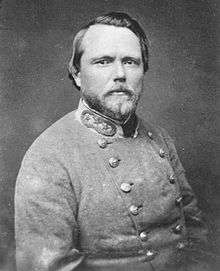Samuel McGowan (general)
| Samuel McGowan | |
|---|---|
 | |
| Born |
October 19, 1819 Laurens County, South Carolina, U.S. |
| Died |
August 9, 1897 (aged 77) Abbeville, South Carolina, U.S. |
| Buried at |
Upper Long Cane Cemetery Abbeville, South Carolina, U.S. |
| Allegiance |
|
| Service/branch |
|
| Years of service |
1846–1847 (U.S.) 1861–1865 (C.S.) |
| Rank |
|
| Unit | Palmetto Regiment (U.S.) |
| Commands held |
14th South Carolina Infantry (C.S.) McGowan's Brigade |
| Battles/wars | |
| Spouse(s) | Susan Caroline Wardlaw McGowan |
| Other work | Lawyer, judge, politician |
Samuel McGowan (October 19, 1819 – August 9, 1897) was a Confederate military officer from South Carolina, who fought in the Confederate army during the American Civil War. He commanded a brigade in A.P. Hill's famous "Light Division" and was wounded several times. Ezra Warner's book, Generals in Gray, claims that "McGowan's career and reputation were not excelled by any other brigade commander in the Army of Northern Virginia."[1]
Early life and education
Born in the Laurens District of South Carolina, McGowan attended and graduated from South Carolina College in 1841, where he was a member of the Clariosophic Society.[2] Subsequently, he studied law in Abbeville and was admitted to the bar. Prior to the Civil War, McGowan practiced law as partner of Thomas C. Perrin and served in state politics. He volunteered for service in the Mexican-American War and enlisted as a private in the Palmetto Regiment. He was commended for his gallantry near Mexico City, rose to the rank of captain and served as quartermaster and staff officer.[3][4]
Career
American Civil War
In late 1860 he was appointed to command a brigade of the South Carolinian militia, being a major general in the same, and was present at the attack on Fort Sumter. At the First Battle of Bull Run, McGowan served as an aide-de-camp on the staff of General Milledge Bonham. In September 1861 he was appointed lieutenant colonel of the 14th South Carolina Infantry; and became the Colonel of the regiment in April 1862. The 14th was assigned to Maxcy Gregg's brigade in A.P. Hill's Light Division. After Gregg was killed in the Battle of Fredericksburg, McGowan was promoted to brigadier general (to rank from January 17, 1863) and took command of the Light Division's South Carolina brigade. One of his fellow officers was Abner M. Perrin, the nephew of his former law partner, who would succeed him in command of the regiment. Except for when wounded, McGowan commanded this brigade for the rest of the war, surrendering with it at Appomattox Court House.[3][4]
McGowan was wounded four times during the Civil War. The first occurrence was at Cold Harbor during the Seven Days Battles on June 27, 1862, where he was bruised in the right side by canister. The second wound happened at Second Manassas when McGowan was hit in the thigh. McGowan suffered his worst wound at Chancellorsville. A Minié ball severely injured McGowan's leg below the knee. Although he kept the leg, it was not until February 1864 that he was able to return to field command. McGowan received his final wound at Spotsylvania where he was hit and suffered a minor wound to the forearm. [3][4]
Reconstruction
Returning to Abbeville after the war ended, McGowan was elected to Congress as a member of the Conservative Party of South Carolina, but refused his seat. He became a leader in the fight against "carpetbagger" influences in the state's legislature. He was elected as an associate justice of the South Carolina Supreme Court in 1879 and served there until July 1894.[4]
Death
McGowan died in Abbeville August 9, 1897 and was buried there in Upper Long Cane Cemetery.[4]
See also
Notes
References
- Brooks, Ulysses Robert (1908). South Carolina Bench and Bar Vol. 1. Columbia, South Carolina: The State Co.
- Catalogue of Regular and Honorary Members of the Clariosophic Society. Columbia, SC: I.C. Morgan. 1842. p. 31.
- Eicher, John H.; Eicher, David J. (2001), Civil War High Commands, Stanford, CA: Stanford University Press, ISBN 978-0-8047-3641-1
- Sifakis, Stewart (1988), Who Was Who in the Civil War, New York: Facts On File, ISBN 978-0-8160-1055-4
- Tucker, Spencer C. (2013). American Civil War: The Definitive Encyclopedia and Document Collection. ABC-CLIO. ISBN 1-8510-9682-5.
- Warner, Ezra J. (1959), Generals in Gray: Lives of the Confederate Commanders, Baton Rouge, LA: Louisiana State University Press, ISBN 978-0-8071-0823-9